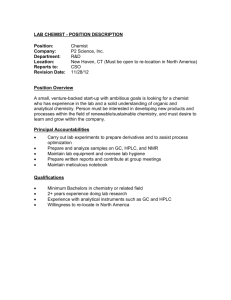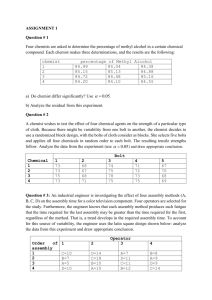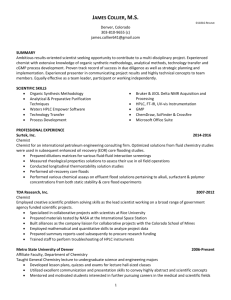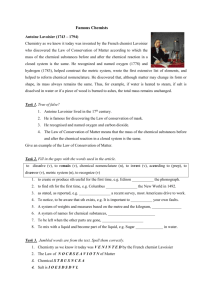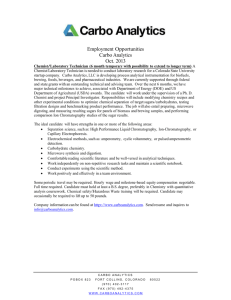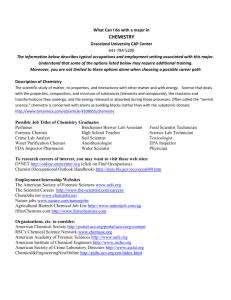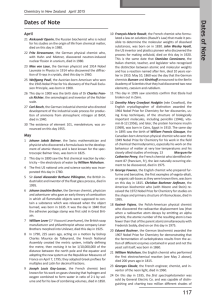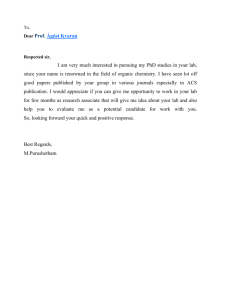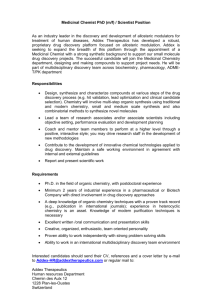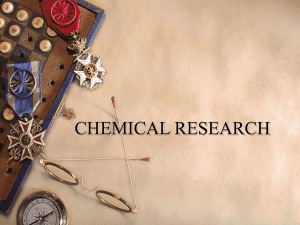Dates of note - New Zealand Institute of Chemistry
advertisement
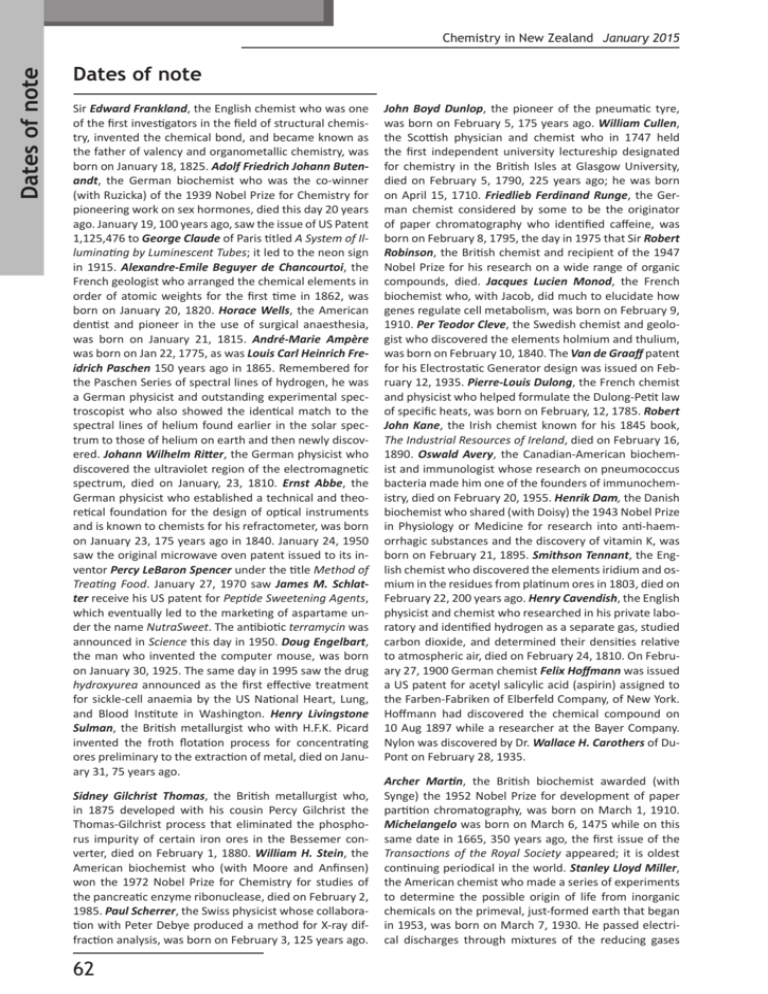
Dates of note Chemistry in New Zealand January 2015 Dates of note Sir Edward Frankland, the English chemist who was one of the first investigators in the field of structural chemistry, invented the chemical bond, and became known as the father of valency and organometallic chemistry, was born on January 18, 1825. Adolf Friedrich Johann Butenandt, the German biochemist who was the co-winner (with Ruzicka) of the 1939 Nobel Prize for Chemistry for pioneering work on sex hormones, died this day 20 years ago. January 19, 100 years ago, saw the issue of US Patent 1,125,476 to George Claude of Paris titled A System of Illuminating by Luminescent Tubes; it led to the neon sign in 1915. Alexandre-Emile Beguyer de Chancourtoi, the French geologist who arranged the chemical elements in order of atomic weights for the first time in 1862, was born on January 20, 1820. Horace Wells, the American dentist and pioneer in the use of surgical anaesthesia, was born on January 21, 1815. André-Marie Ampère was born on Jan 22, 1775, as was Louis Carl Heinrich Freidrich Paschen 150 years ago in 1865. Remembered for the Paschen Series of spectral lines of hydrogen, he was a German physicist and outstanding experimental spectroscopist who also showed the identical match to the spectral lines of helium found earlier in the solar spectrum to those of helium on earth and then newly discovered. Johann Wilhelm Ritter, the German physicist who discovered the ultraviolet region of the electromagnetic spectrum, died on January, 23, 1810. Ernst Abbe, the German physicist who established a technical and theoretical foundation for the design of optical instruments and is known to chemists for his refractometer, was born on January 23, 175 years ago in 1840. January 24, 1950 saw the original microwave oven patent issued to its inventor Percy LeBaron Spencer under the title Method of Treating Food. January 27, 1970 saw James M. Schlatter receive his US patent for Peptide Sweetening Agents, which eventually led to the marketing of aspartame under the name NutraSweet. The antibiotic terramycin was announced in Science this day in 1950. Doug Engelbart, the man who invented the computer mouse, was born on January 30, 1925. The same day in 1995 saw the drug hydroxyurea announced as the first effective treatment for sickle-cell anaemia by the US National Heart, Lung, and Blood Institute in Washington. Henry Livingstone Sulman, the British metallurgist who with H.F.K. Picard invented the froth flotation process for concentrating ores preliminary to the extraction of metal, died on January 31, 75 years ago. Sidney Gilchrist Thomas, the British metallurgist who, in 1875 developed with his cousin Percy Gilchrist the Thomas-Gilchrist process that eliminated the phosphorus impurity of certain iron ores in the Bessemer converter, died on February 1, 1880. William H. Stein, the American biochemist who (with Moore and Anfinsen) won the 1972 Nobel Prize for Chemistry for studies of the pancreatic enzyme ribonuclease, died on February 2, 1985. Paul Scherrer, the Swiss physicist whose collaboration with Peter Debye produced a method for X-ray diffraction analysis, was born on February 3, 125 years ago. 62 John Boyd Dunlop, the pioneer of the pneumatic tyre, was born on February 5, 175 years ago. William Cullen, the Scottish physician and chemist who in 1747 held the first independent university lectureship designated for chemistry in the British Isles at Glasgow University, died on February 5, 1790, 225 years ago; he was born on April 15, 1710. Friedlieb Ferdinand Runge, the German chemist considered by some to be the originator of paper chromatography who identified caffeine, was born on February 8, 1795, the day in 1975 that Sir Robert Robinson, the British chemist and recipient of the 1947 Nobel Prize for his research on a wide range of organic compounds, died. Jacques Lucien Monod, the French biochemist who, with Jacob, did much to elucidate how genes regulate cell metabolism, was born on February 9, 1910. Per Teodor Cleve, the Swedish chemist and geologist who discovered the elements holmium and thulium, was born on February 10, 1840. The Van de Graaff patent for his Electrostatic Generator design was issued on February 12, 1935. Pierre-Louis Dulong, the French chemist and physicist who helped formulate the Dulong-Petit law of specific heats, was born on February, 12, 1785. Robert John Kane, the Irish chemist known for his 1845 book, The Industrial Resources of Ireland, died on February 16, 1890. Oswald Avery, the Canadian-American biochemist and immunologist whose research on pneumococcus bacteria made him one of the founders of immunochemistry, died on February 20, 1955. Henrik Dam, the Danish biochemist who shared (with Doisy) the 1943 Nobel Prize in Physiology or Medicine for research into anti-haemorrhagic substances and the discovery of vitamin K, was born on February 21, 1895. Smithson Tennant, the English chemist who discovered the elements iridium and osmium in the residues from platinum ores in 1803, died on February 22, 200 years ago. Henry Cavendish, the English physicist and chemist who researched in his private laboratory and identified hydrogen as a separate gas, studied carbon dioxide, and determined their densities relative to atmospheric air, died on February 24, 1810. On February 27, 1900 German chemist Felix Hoffmann was issued a US patent for acetyl salicylic acid (aspirin) assigned to the Farben-Fabriken of Elberfeld Company, of New York. Hoffmann had discovered the chemical compound on 10 Aug 1897 while a researcher at the Bayer Company. Nylon was discovered by Dr. Wallace H. Carothers of DuPont on February 28, 1935. Archer Martin, the British biochemist awarded (with Synge) the 1952 Nobel Prize for development of paper partition chromatography, was born on March 1, 1910. Michelangelo was born on March 6, 1475 while on this same date in 1665, 350 years ago, the first issue of the Transactions of the Royal Society appeared; it is oldest continuing periodical in the world. Stanley Lloyd Miller, the American chemist who made a series of experiments to determine the possible origin of life from inorganic chemicals on the primeval, just-formed earth that began in 1953, was born on March 7, 1930. He passed electrical discharges through mixtures of the reducing gases Chemistry in New Zealand January 2015 hydrogen, ammonia, methane and water, believed to have formed the earliest atmosphere. Analysis days later showed the resulting chemicals to include the simplest amino acids glycine and alanine. Also on this day in 1900 was born Fritz Wolfgang London, the German-American physicist who with Heitler, devised the first quantum mechanical treatment of the hydrogen molecule while working with Schrödinger. Sir Alexander Fleming, the Scottish bacteriologist who discovered penicillin, died on March 11, 1955. On this day in 105 AD, Ts'ai Lun invented paper in China, making it from bamboo, mulberry, and other fibres, fish nets and rags. John Frederic Daniell, born on March 12, 1790, was the British chemist and meteorologist who invented the Daniell cell, a major improvement on the voltaic cell used in the early days of battery development. He died on March 13, 1845. Arthur Rudolf Hantzsch, the German who gained fame at the age of 25 for devising the synthesis of substituted pyridines then studied stereochemistry of such nitrogen compounds, died on March 14, 1935, 80 years ago. He synthesised pyridine (1882), cumaron (benzofuran, 1886) and thiazole (1889), and provided a nomenclature for heterocyclic compounds. This same day in 1960 saw the Grand Isle sulfur mine begin operation about 7 miles off the Louisiana coast. On March 17, 1950, 65 years ago, element 98 (californium) was announced by scientists at the University of California at Berkeley. Frédéric JoliotCurie was born on March 19, 1900. He was the French physical chemist and husband of Irène, jointly awarded the 1935 Nobel Prize for Chemistry for their discovery of artificial radioactive isotopes of new elements. They were the son-in-law and daughter of Nobel Prize winners Pierre and Marie Curie. Sir Norman Haworth, the British carbohydrate chemist, died on his 67th birthday, March 19, 1950. Torbern Olof Bergman, the Swedish chemist who experimented with carbon dioxide named aerial acid by him, which Priestley called fixed air, was born on March 20, 1735, 280 years ago. On March 21, 1925, Wolfgang Pauli published his exclusion principle in Zeitschrift für Physik. On March 22, 1960, the first laser was patented by Arthur Schawlow and Charles Hard Townes under the title Lasers and Laser Communications System and one day later but in 1840, chemist John William Draper took the first successful photo of the Moon. Wilhelm Conrad Röntgen, a recipient of the first Nobel Prize for Physics, in 1901 for his discovery of X-rays, was born on March 27, 1845. Wilhelm Körner, the German organic chemist who showed how to determine the positions of the substituents on di- and tri-substituted isomers of the benzene ring in 1878 by counting product or source isomers, died on March 28, 1925. Sir Lawrence Bragg was born on March 31, 1890. Isidor Traube, the German physical chemist who founded capillary chemis- try and whose research on liquids advanced knowledge of critical temperature, osmosis, surface tension and colloids, was born the same day in 1860. Hans Fischer, the German biochemist who was awarded the 1930 Nobel Prize for Chemistry for his research into the constitution of haemin and chlorophyll, and especially for his synthesis of haemin, the non-protein part of haemoglobin that gives blood its red colour, died on March 31, 1945. Richard Zsigmondy, the Austro-German chemist who was awarded the 1925 Nobel Prize for Chemistry for his demonstration of the heterogeneous nature of colloid solutions and the methods which have since become fundamental in modern colloid chemistry, was born on April 1, 150 years ago. Marc Antoine Augustin Gaudin, the French crystallographer and chemist who contributed to the early chemistry of photography, died on April 2, 1880. Richard Wilhelm Heinrich Abegg, the German physical chemist who, with Boländer proposed a theory of valency to explain the capacity of an atom to combine with another atom in light of the [then (1899) newly discovered] presence of electrons within the atom, died on April 3, 1910. Edmond H. Fischer, the American biochemist who shared (with Krebs) the 1992 Nobel Prize for Physiology or Medicine for the discovery of reversible protein phosphorylation as a biological regulatory mechanism, was born on April 6, 1920. On April 7, 1795, France adopted, by law, the metre as the unit of length and the base of the metric system. William Prout, the English biochemist and physiologist who is noted for his discoveries concerning digestion, metabolic chemistry, and atomic weights, died on April 9, 1850. Julius Lothar Meyer, the German chemist who discovered the Periodic Law at about the same time but independently of Dmitry Mendeleyev, died on April 11, 1895. William Cookworthy, the English chemist who pioneered the manufacture of porcelain in Britain, was born on April 12, 1705. Charles Fredrick Cross, the English chemist who, with Bevan and Beadle, discovered that cellulose could be produced (1891) by the dissolution of cellulose xanthate in dilute NaOH and in 1892 found that cellulose dissolved in CS2 producing a solution he called viscose capable of extrusion into what became known as viscose, died on April 15, 1935. Albert Einstein died on April 18, 1955 as did Gerardus Johannes Mulder, the Dutch chemist known for his analysis and naming the ‘protein’, 1800. Percy L. Julian, the African-American chemist, whose 100 patents include the synthesis of cortisone, various hormones and other products from soybeans, died on April 19, 1975. Aleksandr Oparin, the Russian biochemist noted for his studies on the origin of life from chemical matter, died on April 21, 1980. 63
